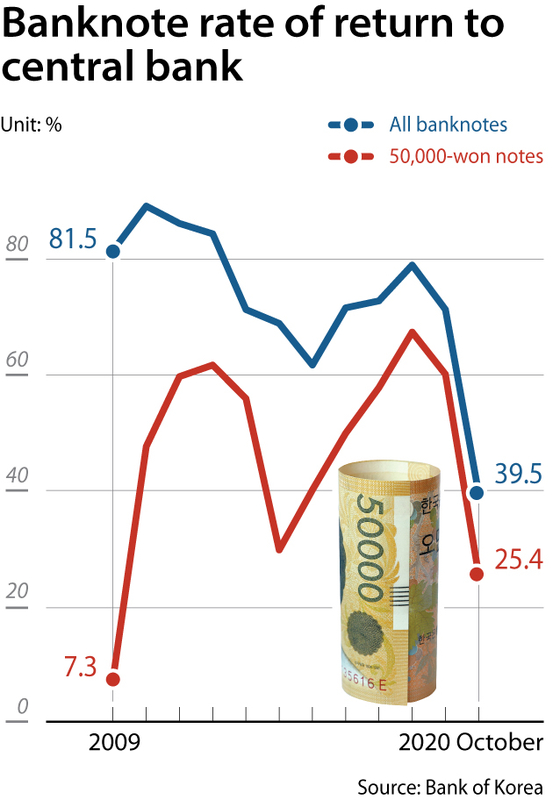₩50,000 banknotes on the lam as cash is king

People seem to be hoarding 50,000-won ($45) bills, as fewer are ending up back in the vaults of the central bank.
Bills are regularly returned to the Bank of Korea (BOK) by commercial banks with too many on hand as a result of deposits and for destruction because they are damaged.
The central bank said this year that through October, the number of 50,000-won notes sent to it is 25.4 percent of the total outstanding, down a 35.7 percentage point on year. This value is much lower than last year’s 60.1 percent and 67.4 percent in 2018.
In 2009, when the note was first produced, the rate of return was 7.3 percent. The value was as high as 61.7 percent in 2012. In 2014, it dropped back to 25.8 percent, similar to this year’s value. The rate increased for four years until 2018.
The bank said that many countries have experienced the same drop in returns during the pandemic, as the demand for high-value notes has spiked.
This year, 21.9-trillion-won worth of the 50,000-won bills has been printed, and 5.6 trillion won of that has returned. The rest, 16.4 trillion won, is still out in the market. It is possible that the net printed amount, which is the total printed minus total returned, will break the previous record of 12.3 trillion won in 2015.
Concerns have been raised that this money is flowing into the underground economy.
The bank said the decrease in in-person commercial transactions at restaurants and lodging businesses along with people’s tendency to save banknotes during the coronavirus pandemic were the causes. According to the report, the central bank found that the input of banknotes into ATM machines at duty-free stores and casinos at tourist locations fell by a large amount, affecting the distribution of the banknotes.
The bank also explained that the growing tendency of economic participants to hold onto cash due to low interest rates contributed to the low rate of return. When the interest rate is high, people expect gains from putting cash into bank accounts, but when the interest rate is low, more people are willing to keep the cash with them. The BOK lowered the base rate to 0.5 percent in two stages, the lowest since the base rate was first introduced.
“Other countries are exhibiting similar conditions, so it is unlikely that structure issues like the underground economy played a significant role,” said a spokesperson for the central bank.
BY JEONG YON-HWAN, LEE JEE-YOUNG [lee.jeeyoung1@joongang.co.kr]










with the Korea JoongAng Daily
To write comments, please log in to one of the accounts.
Standards Board Policy (0/250자)